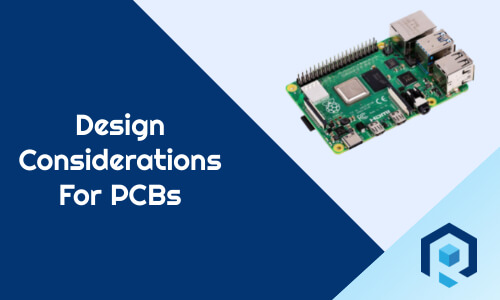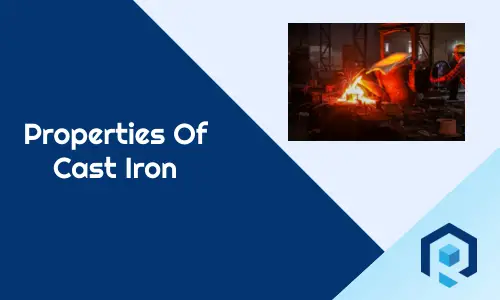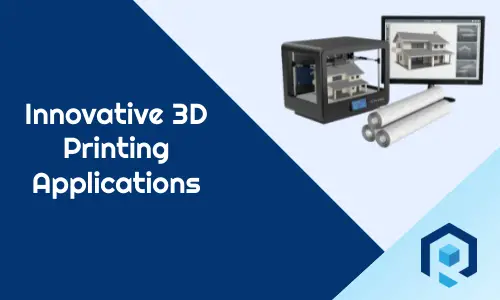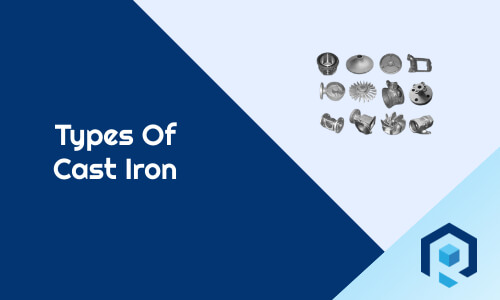Chips are the pieces of material that are removed from a workpiece with the help of a cutting tool during metal cutting or machining. In this article, we will learn about the different types of chips in metal cutting, their advantages, and their disadvantages.
What are Chips in metal cutting?
Chips are small pieces of metal removed from a workpiece during machining. Different types of chips are produced in the machining process based on parameters such as the behavior and nature of the material being machined, the extent and nature of the interaction between chip interfaces, and the amount of energy required to extract the materials.
Types of Chips in Metal Cutting
The following types of chips are produced during the metal-cutting process.
1. Continuous Chip
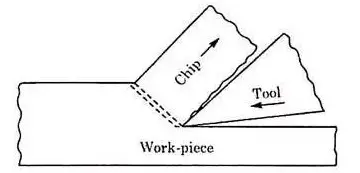
These chips are formed during the machining of more ductile materials. As a result of the massive plastic deformations that can occur with ductile materials, longer continuous chips are produced. It is the best chip to use because of its consistent cutting and the high-quality finish it produces. But these chips are cumbersome to work with and hazardous to throw away.
Chips can cause injury to the operator if they break loose and spiral in a helix pattern around the workpiece and the tool. More heat is generated from friction because this sort of chip continues to rub against the tool’s face for a longer time.
A chip breaker often mounted on the tool face or machine on the tool face, is used to prevent these problems. The chip breaker is designed to break chips by minimizing their curvature along a single axis.
Continuous chips are also produced under the following cutting conditions:
- Copper, aluminum, and mild steel are ductile materials that could be used.
- The chips should be of a small size.
- High cutting speeds are ideal for machining.
- The coefficient of friction between the tool and its surface must be small.
- The friction between the tool face and the chip should be kept to a bare minimum.
- The angle of the tool’s rake could be quite steep.
- It is important to utilize an effective cutting lubricant.
Advantages of Continuous Chip
- The malleable material needs a higher-quality surface treatment.
- Reduced wear and tear means tools last much longer
- Reduced friction between the cutting tool and the chip means less heat.
- For Continuous chips, low energy is required.
.Disadvantages of Continuous Chip
Because chips that don’t break are hard to handle and get rid of, chip breakers are used to stop them.
2. Discontinuous Chip
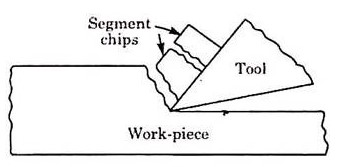
When cutting brittle materials (such as cast iron, bronze, and high-carbon steel), which require slow cutting speeds, chips are formed in pieces. They are loosely joined together initially. but periodic cracks appear on the chip flow, the material loses its flexibility and fractures during deformation.
At this stage of chip creation, the cutting pressures are constantly shifting. High feed rates, deep cuts, and lots of tool-chip friction all contribute to the creation of these chips.
Poor surface finish and decreased tool life are the consequences of discontinuous chips when cutting brittle materials. Discontinuous chip production is greatly influenced by the stiffness of the cutting tool and holding devices since insufficient stiffness can lead to vibration, dimensional inaccuracy, poor surface smoothness, and even damage to the cutting tool.
Discontinuous chips, in contrast to continuous chips, are convenient due to their manageability and small length. It’s also simple to throw away after use.
Advantages of Discontinuous Chips
- Discontinuous chips have a great finish on the outside of naturally brittle materials.
- Discontinuous chips use less power.
- Discontinuous chips give tools a long life span.
Disadvantages of Discontinuous Chips
Ductile metal has poor surface quality, and increases wear and tear.
3. Continuous Chip with Built-up Edge
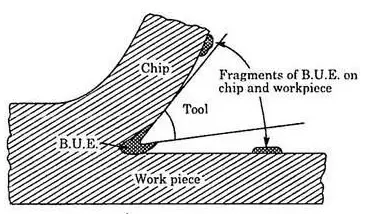
This type of chip is very similar to the continuous type, except that it is not as smooth as the previous one. It has raised edges that stick to the tool’s nose. The built-up edge changes the way cutting works.
It is made by cutting ductile metals with high-speed tools at normal cutting speeds, which causes a lot of friction between the metal chip and the tool’s face.
The shape and size of this edge depend greatly on how fast the blade moves. The edge doesn’t appear when the blade moves very slowly or quickly. This type of chip has a rough surface, but it protects the cutting edge from wear caused by the movement of chips and the action of heat, which makes the tool last longer.
The main things that cause a built-up edge are the cutting speed, the tool’s angle, the cutting edge’s condition, a rough feed, not enough cutting fluid, etc. Machining metals at higher cutting speeds allows the formation of built-up edges to be slowed down because there is less friction between the tool chip and the metal.
Advantages of Continuous Chip with Built-up Edge:
High friction protects tools from breakage, and continuous chips with built-up edges extend their useful life.
Disadvantages of Continuous Chip with Built-up Edge:
While continuous chips with built-up edges can reduce cutting forces and rake angle, the main disadvantage is that they provide a rough surface finish.
4. Non-homogeneous Chip
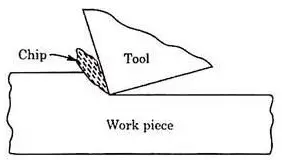
This kind of chip looks like a saw because it has large areas of high shear strain and small areas of low shear strain. Because the chips form cyclically, it becomes almost continuous. This kind of chip forms when hard-to-cut materials, like titanium alloys, nickel-based superalloys, and austenitic stainless steel, are machined at high cutting speeds.
Conclusion: Types Of Chips In metal Cutting
Metal chips are formed when the workpiece is machined to give it the needed shape. These chips are made when the friction between the tool and the workpiece is high, the cutting speed is slow, and the rake angle is short. The chips can be continuous, discontinuous, or continuous with a built-up edge and non-homogeneous. So many things affect the kinds of chips that are made during machining.
You may also like to read: What is honing process
